 W
WThe Abbey in the Oakwood is an oil painting by Caspar David Friedrich. It was painted between 1809 and 1810 in Dresden and was first shown together with the painting The Monk by the Sea in the Prussian Academy of Arts exhibition of 1810. On Friedrich's request The Abbey in the Oakwood was hung beneath The Monk by the Sea. This painting is one of over two dozen of Friedrich's works that include cemeteries or graves.
 W
WCabin in the Snow or Cabin under Snow is a painting by Caspar David Friedrich, first exhibited at the exhibition held by the Dresden Academy of Fine Arts, from which it was acquired by John I of Saxony.
 W
WCaspar David Friedrich in his Studio refers to two paintings by the German romantic artist Georg Friedrich Kersting of 1811 and 1819. Of these the 1819 version is the best known. In these two paintings Kersting depicted fellow German painter Caspar David Friedrich in his studio.
 W
WFalcon Attacking a Pigeon is a painting by Adolph Menzel, produced in 1844 as a hunting target. It is now in the Alte Nationalgalerie in Berlin.
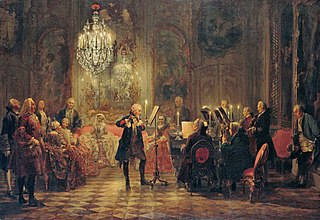 W
WFrederick the Great Playing the Flute at Sanssouci or The Flute Concert is an 1852 oil on canvas history painting by the German painter Adolph Menzel. It depicts Frederick the Great, King of Prussia playing the flute at an evening concert at Sanssouci and is now in the Alte Nationalgalerie in Berlin.
 W
WGothic Cathedral by a River is an 1813 painting by Karl Friedrich Schinkel. It shows an imaginary Gothic cathedral on an island in a river - Schinkel later became a noted proponent of neo-Gothic architecture. It is now in the Alte Nationalgalerie in Berlin.
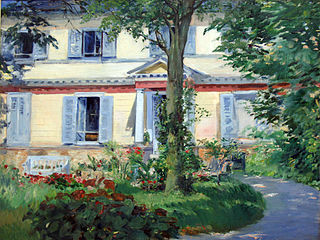 W
WThe House at Rueil is the title of two oil-on-canvas paintings by Édouard Manet completed in 1882. The paintings depict a view of the house where Manet and his family stayed for a few months before his death. The two versions are almost identical, but one is in landscape format, and the other is portrait format. The landscape version measures 71.5 × 92.3 cm and is in the collection of the Alte Nationalgalerie in Berlin, Germany, whereas the portrait version measures 92.8 × 73.5 cm and is at the National Gallery of Victoria in Melbourne, Australia. The composition shows typical characteristics of Impressionism and influenced various painters in the early 20th century who created similar works based on this model.
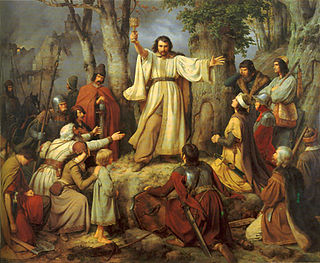 W
WThe Hussite Sermon is a painting by the Düsseldorf-based painter Carl Friedrich Lessing, showing an open-air sermon being delivered by a Hussite preacher in the 15th century. It is now in the Alte Nationalgalerie in Berlin.
 W
WIn Summer is an 1868 oil-on-canvas painting by Pierre-Auguste Renoir, a portrait of Lise Tréhot aged about 20.
 W
WIn the Conservatory is an 1879 oil painting by Édouard Manet in the Alte Nationalgalerie, Berlin, depicting Manet's friends, a couple, in a conservatory. There is an ambiguity in the painting that has led art critics to characterize the couple's relationship in divergent ways.
 W
WIsle of the Dead is the best-known painting of Swiss Symbolist artist Arnold Böcklin (1827–1901). Prints were very popular in central Europe in the early 20th century—Vladimir Nabokov observed in his 1936 novel Despair that they could be "found in every Berlin home".
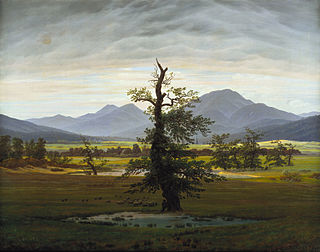 W
WThe Lonely Tree is an 1822 oil-on-canvas painting by German painter Caspar David Friedrich. It measures 55 × 71 centimetres (22 × 28 in). The work depicts a panoramic view of a romantic landscape of plains with mountains in the background. A solitary oak tree dominates the foreground.
 W
WTwo Men Contemplating the Moon and Man and Woman Contemplating the Moon are a series of similar paintings by Caspar David Friedrich, the setting being among his best-known works. Friedrich painted at least three versions, with one variation featuring a man and a woman. The 1819–20 version in the Galerie Neue Meister is thought to be the original; the c. 1824 variant with a woman is in the Alte Nationalgalerie; and the c. 1830 version is in the Metropolitan Museum of Art.
 W
WMedieval City on a River is an 1815 oil on canvas painting by the Prussian architect/artist Karl Friedrich Schinkel which is now in the collection of the Alte Nationalgalerie, Berlin.
 W
WThe Meeting of Frederick II and Joseph II in Neisse in 1769 is an oil on canvas history painting by Adolph Menzel, executed in 1855-1857, showing the meeting of Frederick II of Prussia with Joseph II, Holy Roman Emperor at Neisse on 25 August 1769. It is now in the Alte Nationalgalerie in Berlin.
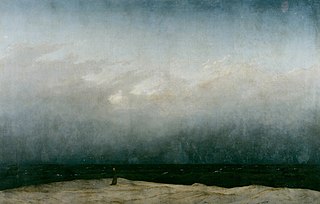 W
WThe Monk by the Sea is an oil painting by the German Romantic artist Caspar David Friedrich. It was painted between 1808 and 1810 in Dresden and was first shown together with the painting The Abbey in the Oakwood in the Berlin Academy exhibition of 1810. On Friedrich's request The Monk by the Sea was hung above The Abbey in the Oakwood. After the exhibition, both pictures were bought by king Frederick Wilhelm III for his collection. Today, the paintings hang side by side in the Alte Nationalgalerie, Berlin.
 W
WMoonrise by the Sea or Moonrise over the Sea is an 1822 oil-on-canvas painting by German painter Caspar David Friedrich. The work depicts a romantic seascape.
 W
WThe Port of Greifswald is an 1818-1820 painting by Caspar David Friedrich, showing a scene in the Bay of Greifswald. It is now in the Alte Nationalgalerie in Berlin, who acquired it in 1919.
 W
WPortrait of Pauline Hübner is an oil on canvas portrait by Julius Hübner of his new wife, Pauline Charlotte. He produced it just after their marriage in 1829 and it is held to belong to the Düsseldorf school of painting. It is now in the Alte Nationalgalerie in Berlin.
 W
WThe Reading Room is an 1843 painting by the Düsseldorf-based painter Johann Peter Hasenclever, now in the Alte Nationalgalerie in Berlin. It shows a genre scene of middle-class men in a reading room, reflecting the political and cultural situation of the Vormärz period. A smaller copy is now in the Städtische Museum Remscheid.
 W
WRemembrance of Tivoli is a painting by the German artist Anselm Feuerbach, produced during his 1866 stay in Rome. It shows two Italian peasant children in Tivoli. It is now in the Alte Nationalgalerie in Berlin.
 W
WRoger Freeing Angelica is an oil painting by Swiss symbolist painter Arnold Böcklin, from 1873. The painting illustrates a scene from Ariosto's epic Orlando Furioso, in which the Muslim knight Roger saves the pagan princess Angelica from a sea monster. The motif is closely related to the mythological theme of Perseus saving Andromeda.
 W
WSelf-Portrait with Death Playing the Fiddle is a painted self-portrait executed in 1872 by the Swiss symbolist artist Arnold Böcklin. He first exhibited at the Kunstverein München in the same year, establishing his reputation in Munich's artistic community. It is now in the Alte Nationalgalerie in Berlin.
 W
WThe Sin is an 1893 painting by the German artist Franz Stuck. It depicts the nude Eve with a large serpent wrapped around her body. In the upper right corner is a bright field, while the rest of the surroundings are dark.
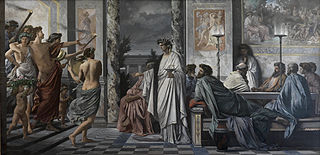 W
WSymposium or Das Gastmahl des Platon are paintings by the German painter Anselm Feuerbach from c. 1869 and 1873/74 of a moment from Plato's Symposium, when the drunken Alcibiades and revelers enter the house of the poet Agathon. Socrates, near the wall at right-centre, turns his back on the scene, and bows his head.
 W
WTwo Men by the Sea is a painting by Caspar David Friedrich, first exhibited at the exhibition held by the Dresden Academy of Fine Arts in 1817, from which it was acquired a representative of mother superior Maria Richter of Berlin. It first appears in the inventories of the Nationalgalerie in 1936 as number A II 884. It was displayed at the Schloss Charlottenburg until 1967 and from 1986 to 2001 it was hung in the Schloss' Knobelsdorff wing. Since 2001 it has been displayed in the Alte Nationalgalerie in Berlin.
 W
WTwo Men Contemplating the Moon and Man and Woman Contemplating the Moon are a series of similar paintings by Caspar David Friedrich, the setting being among his best-known works. Friedrich painted at least three versions, with one variation featuring a man and a woman. The 1819–20 version in the Galerie Neue Meister is thought to be the original; the c. 1824 variant with a woman is in the Alte Nationalgalerie; and the c. 1830 version is in the Metropolitan Museum of Art.
 W
WThe Watzmann is an 1824-1825 oil on canvas painting by Caspar David Friedrich, showing the Watzmann mountain as seen from Berchtesgaden to the north-east. It is now on display in the Alte Nationalgalerie in Berlin.
 W
WWhite Lilacs in a Glass Vase is an 1882 painting by Édouard Manet, now in the Alte Nationalgalerie in Berlin. Showing cuttings of white lilacs in a glass vase, it is one of a series of flower still lifes by the painter.
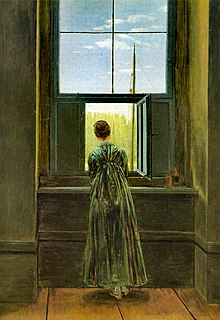 W
WWoman at a Window is an 1822 oil painting by the German Romantic artist Caspar David Friedrich. This painting is currently located in Alte Nationalgalerie, Berlin. The painting depicts an interior with a woman, seen from behind, peering out an opened window. Beyond the window, the masts of ships are visible. The woman in the piece is Friedrich's wife Caroline and the view from the window is from his studio overlooking the Elbe river in Dresden. Friedrich submitted his work to be exhibited at the Dresden Academy, however he did not complete the piece in time to be in the main exhibition.